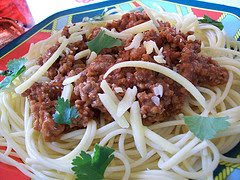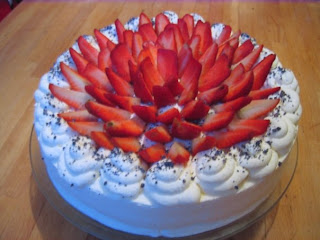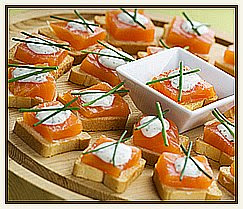Smoked Salmon is fresh salmon that has undergone a smoking process, usually by one of two methods-hot-smoking or cold-smoking. Most of supermarkets sell both types of smoked salmon. However, the delicate flavour of cold-smoked salmon makes it becomes people’s favourite. Also, it is very easy to use in cooking, either directly put on soda bread with sour cream as canapé, or slightly cooked in pasta.
Cured Salmon is practically raw fish. The method has been used for centuries to prevent food from spoiling. The process usually involved good quantity of sugar or salt or both. Herbs or citrus peel can be put into to make a dry rub mix which is then applied onto surface of the fish. It takes a few days to a week to ‘cook’ the fish, depends on the size of the fish. The sugar and salt draws a large amount of liquid from the fish and replacing it with sugar/salt mixture, thus gives the fish ‘cooked’-liked finish.
Even though, they are different in making process, their tastes are similar and can be applied in cooking in same way. However, of course, cured salmon has no smokiness.
Gravlax
This Swedish speciality of raw salmon cured in sugar-salt –dill mixture is famous around the world. The fish is sliced paper-thin and served on dark bread with mustard-dill sauce as appetizer.
I adopted the original recipe and came up with a citrus-flavoured cured salmon. I love it, and all of my family and friends love it, why don’t you give it a try.
450g/1lb salmon fillet (preferably middle-cut), pin bones removed
25g/1oz coarse sea salt
25g/1oz caster sugar
1 tsp crushed white peppercorns
1 lemon, zest only
Get two salmon fillets of total weight 450g/1lb. Ideally, they are about the same size. Wash the fillets and towel dries them.
Then mix the salt, sugar, pepper and zest in a mixing bowl. Lay a large piece of cling film on your worktop, and then put a quarter of the salt mix in the centre of the cling film. Put one fillet on top of the salt, skin side down. Then rub and other 2 quarters of the mixture on the salmon, put another piece of salmon on top, sprinkle the rest of the salt on top.
Wrap the fish with the cling film tightly. Then place the parcel on a shallow dish to prevent leaking of the liquid. Place another plate on top of the parcel, and apply some weight. Keep the fish in fridge for at 48 hours but no more than 3 days. Some liquid may leak out from the parcel, but don’t worry, that’s normal.
Before serve, unwrap the parcel, wash off any residual mixture from the fish with cold water, and then serve it the way you like.
------------------------------------------------------------------------------------------------
Spaghetti Bolognese 
A world famous pasta dish that everyone loves, Spaghetti Bolognese is originated in Bologna, Italy. This pasta dish is with a meat based sauce, sometimes taken to be tomato sauce. However, the original recipe has very small amount of tomato paste, perhaps a couple of tablespoons.
The traditional ingredients of Bolognese sauce (Ragù) were confined by the recipe issued in 1982 by the Bolognese delegation of Accademia Italiana della Cucina. It involves beef, pancetta, onions, carrots, celery, tomato paste, meat broth, white wine, and milk. However, there are numerous of interpretation worldwide, and nowadays the term ‘Bolognese’ usually applied to a meat-tomato sauce, which vaguely bear the resemblance of traditional Ragù.
Ma Luk’s Spaghetti BologneseServes: 4
450g/1 lb mince beef
3 cloves garlic, crushed and chopped
1 large onion, finely chopped
2 tomatoes, coarsely chopped
750ml pasta sauce
1 teaspoon sugar
Salt and pepper
150g Cheddar cheese, grated
350g dried pasta (Spaghetti, Penne, Rigatoni or Tagliatelle or any pasta you like)
30g butter, cut into knobs
1 tablesppon olive oil
2 teaspoon sugar
3 tablespoon ketchup
Heat 2 tablespoon of oil in a frying pan, fry garlic and onion to golden brown but do not burn, then fry the mince until just cooked.
Tip away some of the oil in the pan, then add the sauce, tomatoes and sugar. Stir through the mince and let it simmer for 15-20 minutes uncovered or until the sauce is reduced to two-third. Then add salt and pepper to taste. Set aside.
Preheat a 220oF/ gas mark 4-5 oven. Meanwhile, boil a large pan of salted water. Put the pasta into boiling water. Stir to avoid sticking and cook for 10-15 minutes or until al-dente.
Strain the pasta through a colander, put the pasta back into the pan. Put butter, oil, sugar and ketchup onto the pasta and mix until all pasta are coated.
Pour the pasta into a casserole dish, add the Bolognese on top, sprinkle grated cheese all over the top, then bake it in oven until the cheese is melted and golden.
Ben’s Spag Bog
Serves: 4
450g/1 lb mince beef
3 cloves garlic, crushed and chopped
1 large onion, finely chopped
1 tinned chopped tomatoes
300ml passata
1/2 tablespoon tomato paste
1 tablespoon dried oregano
1 teaspoon sugar
Salt and pepper
350g pasta
Parmesan cheese, finely grated to serve
Heat the pan with a few tablespoon of olive oil, then shape the beef into small meatballs, about less than an inch diameter and brown them all round. Remove them from the pan and set aside.
Use the same pan, fry the onion and garlic until golden but do not burn them. Pour in the tinned tomatoes, passata, tomato paste and oregano, mix well. Simmer the sauce to reduce to two-third, about 15-20 minutes. Then put the cooked beef balls into the sauce, simmer at low heat. Add salt and pepper to taste.
Boil the pasta according to instruction on the package. Then strain them and put it back to the pan. Stir through a couple spoons of olive oil, then pour the sauce into the pasta, mix through and serve with grated parmesan and extra black pepper.
Tips: if the sauce was runny, but you would like to have good amount of sauce. Thicken the sauce with flour and water mixture (1 tablespoon of flour to 2.5 tablespoon of water). Do not pour the mixture all at once, pour them in portions and stir until it thickens to your like.
As I mentioned before, spaghetti Bolognese has different interpretation. You could put more vegetable, such as mushroom and celery. You also could use basil instead of oregano. I hope you all are happy making spag bog with your own style J
 Strawberries and Chocolate Cake
Strawberries and Chocolate CakeSOLD.jpg)


